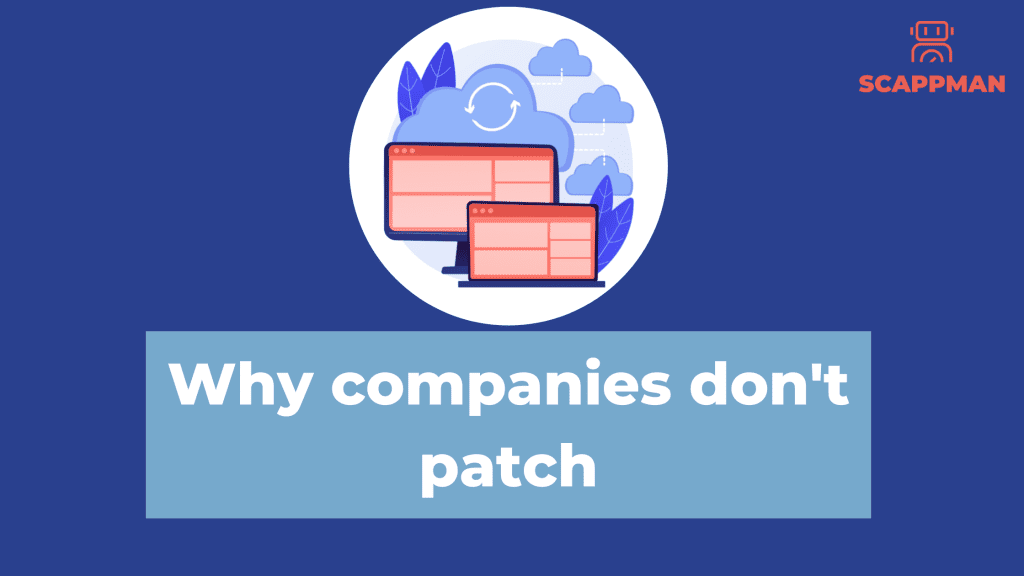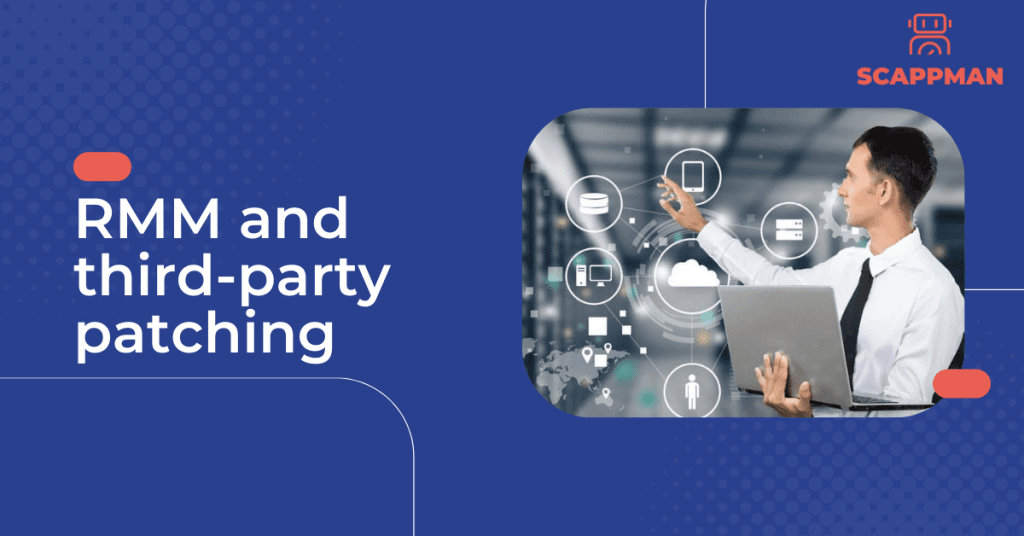Why companies don’t patch

It sounds so simple: always install the latest updates on all operating systems and third-party applications over the entire IT infrastructure. So why is keeping OSs& software up to date one of the most common weak points in companies? Unfortunately, for many IT admins, manual patching has turned into an endless ever-growing task and missing one application update can create a large security hole that affects the entire organization. According to a recent study by the Ponemon Institute, nearly 60% of companies don’t patch their systems on a regular basis. These security holes in your IT system can result in a loss of critical data, violate privacy policies, and eventually lead to security breaches. Just think of all the times when you or your employees postpone the update notifications on their devices. These notifications are important updates that keep your business’s information safe. Ignoring these updates leaves your business vulnerable to data breaches and other security breaches. CVEs in OSs and third-party applications are always being discovered. For example, more than 50 CVEs a day were discovered in 2021. In response software vendors regularly issue patches to cover the security gaps. But patching matters not only for security reasons but also, to increase stability, add new features, change UI, and fix bugs. To know more about patches read our blog “What is Patch Management: stages, best practices, challenges, automated patch management” For all these reasons, patching remains the single most important thing you can do to secure technology in your organization and is why applying patches is often described as the basics. But still, implementation of proper patch management for most companies is easier said than done. We highlighted the top 5 reasons why companies do not patch. Top 5 reasons why companies don’t patch their software Patching can break everything. The most common reason is that there’s a real fear that the solution could become the problem. In some cases, a patch can break something vital in an unpredicted manner. This can be explained by the big number of patches that you have to deploy. Patching takes time. Patching is repetitive, unrewarding task – IT professionals have to regularly check for updates and then install them, which can be a drain on resources. Ideally, they must test the patches before rolling them out fully – which can help uncover any problems they may cause, but which also takes more time and money. Furthermore, some patches can be more difficult to install than others. This can cause delays in getting the updates installed, which can impact business operations. You can only patch something if you know it exists. As it’s hard to maintain accurate, up-to-date asset inventories across big IT systems, many organizations don’t have a clear overview of applications installed, endpoints and other assets. Consequently, if you don’t know which applications you have installed on which devices, you don’t know what to patch. Too many patches to keep up with. Even if companies are able to manage OS updates, third-party application vulnerabilities are often overlooked, leaving endpoints at risk. To illustrate this challenge, we always use this example. Google Chrome releases a full OS update once a week. To package and test the update, an IT specialist spends 3-8 hours. Thus, only for patching Google Chrome, an IT specialist must spend an enormous amount of time, going through the patching cycle 3-4 times a month. An average company uses 110 applications, which means you have to monitor 110 applications for updates. It’s not hard to see how the number of outstanding patches can quickly overwhelm an already busy IT department. End user resistance. Who can relate: you have received an update notification and clicked the “remind me later”? Users just want to get their work done and rarely consider security during their day-to-day operations. The last thing they want is to spend time waiting for the update to be installed or be forced to reboot the laptop. What they do is:“I’ll do it later,” or “it’s probably not important” *click Postpone*. This seemingly innocent event can have serious consequences for the entire business. None of the reasons above (the excuses, we would say) is the actual reasons, that allow you not to patch as much you can. The only solution is automated patch management. Experts say patch automation is critical for easing operational burdens on IT staff and minimizing errors. According to the Ponemon Institute survey (2019), only 44% of organizations used automated solutions for patch management. Automated patch management solutions can help organizations keep track of all of the patches that need to be applied, and they can automate the process of deploying patches and updates. That’s why Scappman should be implemented into patch management in your company. Scappman is a 100%-cloud solution that automatically installs all the necessary updates for your applications. Scappman automates the whole process of uploading the application and updating it in the Microsoft Intune environment. There are more than 800 third-party applications in Scappman App Store, that are always up to date and secure to use. We’ll make sure that hackers can’t use vulnerabilities in outdated applications to steal or encrypt your data. To know more about Scappman and automated third-party patch management book a demo with our team.
What is RMM and why is it still not enough for efficient third-party patching?

As a managed service provider, your main task is to protect and manage the IT systems of various clients. That’s why having a solution that helps you to manage, monitor, support and secure the computer networks and systems of your clients is crucial. By that solution, we mean Remote Monitoring and Management tool (RMM). Although the RMM solution is vital for your customer’s security, it is not enough on its own. Third-party patching is also essential for efficient security IT system. Exactly what is RMM? In short, it’s a tool that makes the work of modern MSPs possible. Read along with us to know more about this technology, the benefits & drawbacks of using RMM, and how you can optimize third-party patching. Definition of RMM: what is remote monitoring & management? RMM (short for remote monitoring and management) is a type of software that allows IT professionals to monitor and manage their client’s IT systems, such as servers, devices, endpoints, and software from anywhere. To make RMM work, it requires to install an agent – a lightweight software installed on clients’ endpoints. This agent allows you to: get real-time insights on the health of the client’s IT environment. see all the data gathered on the RMM’s dashboard, from which you are able to monitor and control all the processes. proactively stay ahead of issues. If the agent detects a problem on one of the managed machines, it creates an alert or “ticket” and delivers it to you, prompting you to take action to resolve a problem before customers even notice it. RMM classifies these tickets based on importance or problem type, helping you prioritize issues. With the growing trend of remote work, however, it’s also becoming more and more common to see internal IT departments also utilizing RMM tools. What is RMM used for? Here are a few core functions of any RMM software: Automating IT management routine. RMM software lets MSPs automate a range of common IT tasks, such as installing software patches, running scripts, asset tracking, monitoring, alerting and remediation of IT incidents. Real-time remote monitoring. RMM solutions can monitor the health of the entire IT system 24/7. IT specialists can be alerted when potential issues arise so that they are addressed in a timely manner. RMM software can also provide real-time reports on network activity, asset inventory, compliance, and system performance. Performing tasks for maintenance and remediation remotely. With RMM, IT specialists can not only monitor the IT system but also deploy software, troubleshoot, and fix problems without interrupting the end user. RMM tools have advanced and become feature-rich, allowing MSPs to do more than just monitoring. With RMM it is possible to secure endpoints and automate a lot of routine tasks, making their life easier. Benefits of RMM Under the right conditions and management, RMM software can help IT providers completely transform their operations, making them more efficient, more effective, and more profitable: No more Break-fix Cycle Previously, MSPs had to physically go to their client’s offices in order to manage their IT systems and infrastructure. It created what was known as the “break-fix cycle”: when something broke, an MSP would fix it, leave, and then come back again when something else broke. This cycle is costly and can be avoided with the help of cloud solutions and remote monitoring and management (RMM). RMM allows you to proactively monitor your IT infrastructure and identify potential issues before they cause downtime. This proactive approach can help keep your business running smoothly. And instead of going to their offices physically, RMM allows MSPs to cut down on time spent on the road, giving them time to manage more clients. Saves time and money RMM can save businesses time by automating tasks that would otherwise need to be done manually. This can free up you to focus on more important tasks, such as problem solving and user support. RMM can also save businesses money by reducing the need for on-site support. With RMM, IT problems can often be fixed remotely, without the need for IT specialists to come to the office. This can save on travel costs and boost productivity. Improves Security An RMM can help identify potential security threats and vulnerabilities early on before they have a chance to do any damage. By constantly monitoring your network and systems, an RMM can quickly spot any suspicious activity and raise an alert. This means that you can take steps to fix the problem before it becomes a serious issue. RMM and third-party patching As the use of third-party applications continues to grow, so do the challenges for patching these applications. While most RMMs support third-party patching, the application list is not broad enough to cover the business needs of your customers. This can pose a challenge for you, as an MSP, who is responsible for patching these applications. One of the biggest challenges is keeping up with the constantly changing versions of these applications. With new versions being released on a regular basis, it can be difficult to ensure that all of the necessary patches are installed. Another challenge is ensuring that the patches are working properly and can’t break anything. That’s why patching third-party applications is an important part of keeping systems up-to-date and secure. How to optimize third-party patch management for RMM Scappman is a 100%-cloud solution that automatically installs all the necessary updates for your applications. Being fully integrated with Microsoft Intune, Scappman doesn’t require any servers or agents to install and keep your applications up to date. For MSPs, Scappman provides a complete third-party patch management solution, that allows you to manage all your customers’ apps from one platform: All customers in one platform. Partner portal (invoicing, inviting customers, pop-up customization…) Advanced application management (app sets, users & group assignments…). Furthermore, there are more than 800 third-party applications in Scappman App Store, that are always up to date and secure to use. You can also upload your own application to the platform and manage


